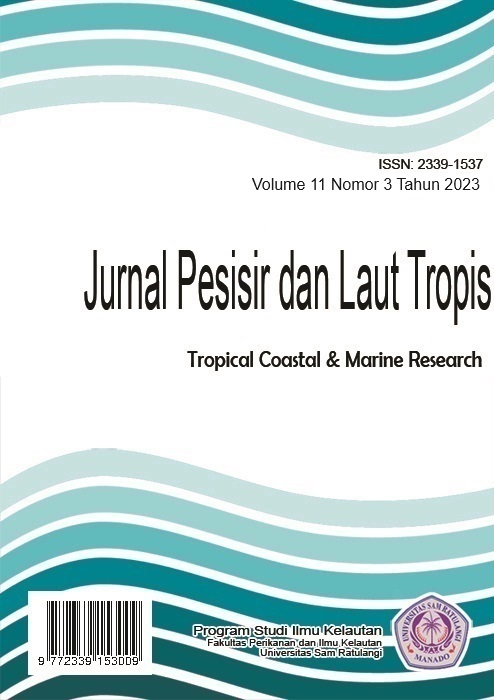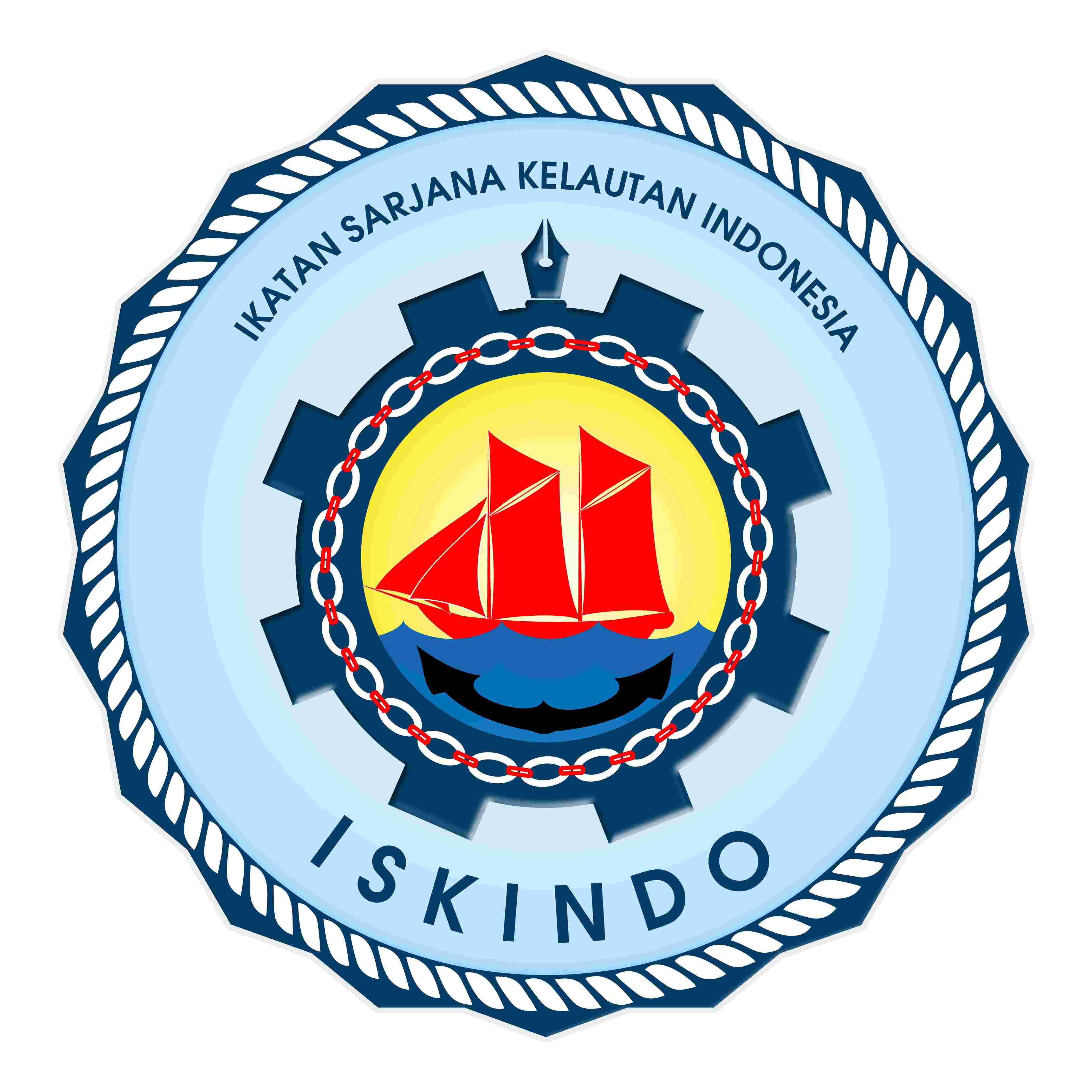KARAKTERISTIK DAN KEPADATAN MIKROPLASTIK PADA SEDIMEN PANTAI LIANG PULAU BUNAKEN
DOI:
https://doi.org/10.35800/jplt.11.3.2023.53377Keywords:
Marine Pollution, Microplastics, Coastal Area, SedimentsAbstract
Mikroplastik merupakan partikel berukuran <5 mm yang berasal dari hasil degradasi limbah plastik. Berdasarkan sumbernya, mikroplastik dibagi menjadi 2 yaitu mikroplastik primer yang sudah berbentuk mikro dari awal pembuatanannya dan mikroplastik sekunder yang merupakan hasil degradasi sampah plastik yang lebih besar. Menurut bentuknya, karakteristik mikroplastik dibedakan menjadi 6 kategori yang meliputi fiber, fragmen, film, busa, granula dan pellet. Keberadaan mikroplastik di suatu lingkungan memiliki dampak yang negatif bagi organisme maupun ekosistem dimana mikroplastik itu berada. Pulau Bunaken merupakan salah satu pulau yang berada di Sulawesi Utara dan termasuk ke-dalam salah satu gugus pulau Taman Nasional Bunaken. Pulau Bunaken dikenal dengan tingkat keanekaragaman hayati yang tinggi serta potensi wisata bahari yang besar. Tingginya tingkat aktivitas manusia yang terjadi di Pulau Bunaken diduga memberikan kontribusi terhadap buangan limbah plastik di perairan. Penelitian ini bertujuan untuk mengidentifikasi karakteristik mikroplastik yang diambil dari sampel sedimen di daerah intertidal Pantai Liang Pulau Bunaken serta mengkuantifikasi kepadatannya. Berdasarkan hasil penelitian yang telah dilakukan, diketahui bahwa Pantai Liang Pulau Bunaken telah terkontaminasi oleh mikroplastik dengan karakterstik mikroplastik berdasarkan bentuknya meliputi fiber, fragmen, film dan busa. Karakteristik warna mikroplastik yang ditemukan meliputi warna biru, merah, putih dan hijau serta kepadatan mikroplastik di pantai tersebut berjumlah 30 Partikel/kg sedimen kering.
References
Adika, S. A., Mahu, E., Crane, R., Marchant, R., Montford, J., Folorunsho, R., & Gordon, C. (2020). Microplastic ingestion by pelagic and demersal fish species from the Eastern Central Atlantic Ocean, off the Coast of Ghana. Marine Pollution Bulletin, 153, 110998.
Allen, A. S., Seymour, A. C., & Rittschof, D. (2017). Chemoreception drives plastic consumption in a hard coral. Marine Pollution Bulletin, 124(1), 198–205.
Andakke, N. J., Tarya, A. (2022). Variasi Sampah Laut di Teluk Manado dan Sekitarnya. Jurnal Ilmiah Platax, 10(2), 224–238.
Browne, M.A. (2015). Sources and Pathways of Microplastics to Habitats. In: Bergmann, M., Gutow, L., Klages, M. (eds) Marine Anthropogenic Litter. Springer, Cham.
Convention on Biological Diversity Scientific and Technical Advisory Panel (CBD). (2012). Impacts of Marine Debris on Biodiversity: Current Status and Potential Solutions. CBD Technical Series No. 67. Secretariat of the Convention on Biological Diversity. Montreal.
Cordova, M. R. (2021). Panduan Metode Sampling, Analisis, dan Identifikasi Mikroplastik di Ekosistem Pesisir dan Laut. IPB Press.
Cordova, M. R. (2017). Pencemaran Plastik Di Laut. OSEANA, 42(3).
Dewi, I. S., Budiarsa, A. A., Ritonga, I. R. (2015). Distribusi mikroplastik pada sedimen di Muara Badak, Kabupaten Kutai Kartanegara. Fishery and Marine Sciences Journal, 4(3): 121-131.
Djaguna, A., Pelle, E. W., Schaduw, N. W., Manengkey, K. W., Rumampuk, C. D., Ngangi, A. L. (2019). Identifikasi Sampah Laut Di Pantai Tongkaina Dan Talawaan Bajo. Jurnal Pesisir dan Laut Tropis, Vol. 7 No. 3.
Enyoh, E. C., Shafea, L., Verla, W. A., Verla, N. E., Qingyue, W. Chowdhury, T., Paredes, M. (2020). Microplastics Exposure Routes and Toxicity Studies to Ecosystems: An Overview. Environmental Analysis Health and Toxicology Journal. Volume 35. Imo State University. (35) 1.
Galgani, F., Hanke, G., Maes, T. (2015). Global Distribution, Composition and Abundance of Marine Litter. In: Bergmann, M., Gutow, L., Klages, M. (eds) Marine Anthropogenic Litter. Springer, Cham.
Hall, N. M., Berry, K. L. E., Rintoul, L., & Hoogenboom, M. O. (2015). Microplastic ingestion by scleractinian corals. Marine Biology, 162(3), 725–732.
Hidalgo-Ruz, V., Gutow, L., Thompson, R. C., & Thiel, M. (2012). Microplastics in the Marine Environment: A Review of the Methods Used for Identification and Quantification.
Hwang, J., Choi, D., Han, S. (2020). Potential toxicity of polystyrene microplastic particles. Sci Rep 10, 7391 (2020).
Jambeck, J. R., Geyer, R., Wilcox, C., Siegler, T. R., Perryman, M., Andrady, A., … Law, K. L. (2015). Plastic waste inputs from land into the ocean. Science, 347(6223), 768–771.
John, J., Nandhini, A. R., Velayudhaperumal Chellam, P., & Sillanpää, M. (2022). Microplastics in mangroves and coral reef ecosystems: a review. In Environmental Chemistry Letters. (20), 397-416
Laila, Q. N., Purnomo, P. W., & Jati, O. E. (2020). Kepadatan Mikroplastik Pada Sedimen Di Desa Mangunharjo, Kecamatan Tugu, Kota Semarang. Jurnal Pasir Laut, 4(1), 28-35.
Laksono, O. B., Suprijanto, J., & Ridlo, A. (2021). Kandungan Mikroplastik pada Sedimen di Perairan Bandengan Kabupaten Kendal. Journal of Marine Research, 10(2), 158-164.
Liao, B., Wang, J., Xiao, B., Yang, X., Xie, Z., Li, D., & Li, C. (2021). Effects of acute microplastic exposure on physiological parameters in Tubastrea aurea corals. Marine Pollution Bulletin, 165, 112173.
Lusher, A. (2015). Microplastics in the Marine Environment: Distribution, Interactions and Effects. In: Bergmann, M., Gutow, L., Klages, M. (eds) Marine Anthropogenic Litter. Springer, Cham.
Manik, R. T. H. K., Makainas, I., Sembel, A. (2016). Sistem Pengelolaan Sampah Di Pulau Bunaken. Jurnal Spasial Perencanaan Wilayah & Kota. Universitas Sam Ratulangi. Vol. 3 No. 1.
National Oceanic and Atmospheric Administration. (2013). Programmatic Environmental Assessment (PEA) for the NOAA Marine Debris Program (MDP). Maryland (US). NOAA. 179 hal
Prata, J. C., da Costa, J. P., Lopes, I., Duarte, A. C., & Rocha-Santos, T. (2019). Environmental exposure to microplastics: an overview on possible human health effects. Science of The Total Environment,
Salinas, D., Ortega, C. I., Torre G. E. (2020). A methodological approach of the current literature on microplastic contamination in terrestrial environments: Current knowledge and baseline considerations. Science of The Total Environment, 730(1).
Schaduw, J. N. W., Bachmid, F., Ronoko, S., Legi, K., Oroh, D., Gedoan, V., Kainde, H. V. F., Pantouw, T., & Tungka, A. (2021). Karakteristik Sampah Laut Pada Daerah Pesisir Pantai Malalayang Kota Manado Provinsi Sulawesi Utara. Jurnal Ilmiah Platax, 9(1), 89–99.
Sundah, G. T., Schaduw, J. N. W., Warouw, V., Kumampung, D. R., Paransa, D. S. J., & Mokolensang, J. (2021). Inventarisasi Sampah Anorganik Pada Ekosistem Mangrove Pulau Bunaken Bagian Timur. Jurnal Ilmiah Platax, 9(2), 262–270.
United Nations Environment Programme. (2011). Emerging issues in our global environment. Nairobi (KE):UNEP. 79 p.
United Nations Environment Programme. (2016). Marine plastic debris and microplastics – Global lessons and research to inspire action and guide policy change. United Nations Environment Programme, Nairobi.
Wright, S. L., Thompson, R. C., & Galloway, T. S. (2013). The physical impacts of microplastics on marine organisms: A review. Environmental Pollution, 178, 483–492.
Yang, Y., Xie, E., Du, Z., Peng, Z., Han, Z., Li., Zhao., Qin, Y., Xue, M., Li, F., Hua, K., Yang, X. 2023. Detection of Various Microplastics in Patients Undergoing Cardiac Surgery. Environmental Science & Technology 57(30), 10911-10918.
You, Y., Thrush, S. F., & Hope, J. A. (2020). The impacts of polyethylene terephthalate microplastics (mPETs) on ecosystem functionality in marine sediment. Marine Pollution Bulletin, 160, 111624.
Downloads
Published
How to Cite
Issue
Section
License

This work is licensed under a Creative Commons Attribution-NonCommercial 4.0 International License.
















